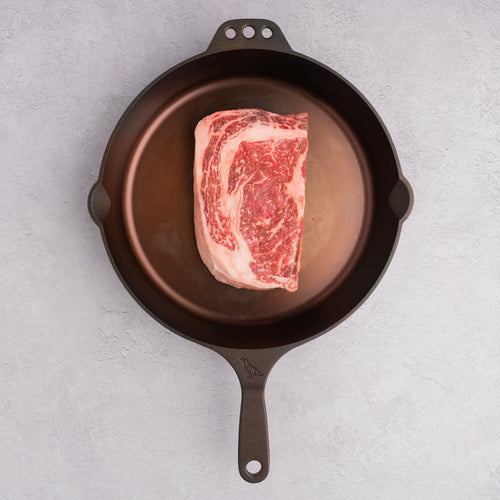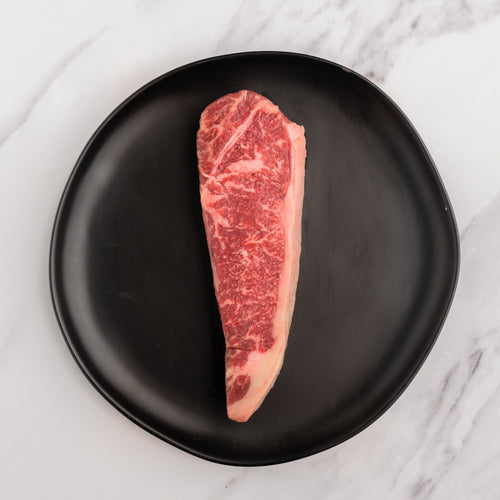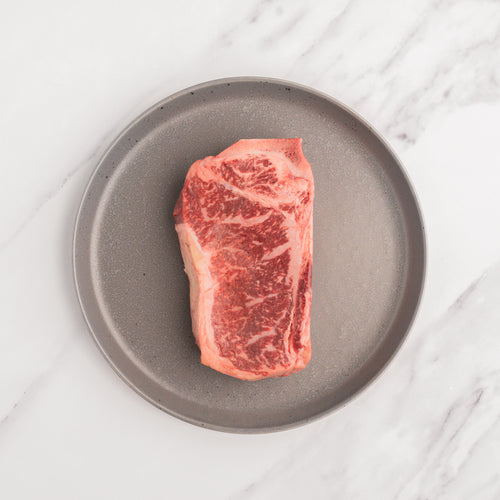The King of Steaks - New York Strip vs. Ribeye

The King of Steaks - New York Strip vs. Ribeye
Ask a steak aficionado to name their favorite cut. Odds are they'll choose a ribeye or New York strip. These two high-end steaks have delicious reputations, but how are they different?
Both are flavorful and tender, but each has unique characteristics. The ribeye is cut from the rib section and possesses abundant marbling and a very tender texture.
The New York strip is cut from the short loin and has generous marbling, but more moderate than the ribeye. This steak also has a firmer texture.
Learn more about these two steaks, their differences, and the variety of ribeyes and New York strips available from Snake River Farms.
When it comes to steak, you have many choices. Yet the New York strip and ribeye steaks rank high on the Top Ten for steak lovers. You really can’t go wrong with either one. Both are marbled, tender and packed with flavor. Let’s take a closer look at the differences between these two cuts, how they taste, and which one is truly the King of Steaks.
Meatology
A significant difference between the New York strip and the ribeye is where they are sourced on beef cattle. Butchers separate a beef carcass into large sections, known as primals. The rib primal and the loin primal sit at the top and middle of animal. The rib primal is located toward the front and the loin sits directly behind.
The ribeye comes from the rib primal located closer to the front and the New York strip is sourced from the loin primal positioned at the back. The primary muscle that runs through both these primals is called the longissimus dorsi. Keep in mind that beef cattle are large and although it’s the same muscle, it doesn’t maintain the same structure from front to back.
What does this mean for the two steaks in question? The ribeye is from the front portion of the longissimus dorsi and is wrapped by the spinalis dorsi also known as the cap of ribeye. When you look at a ribeye, you can see the two distinct parts of the steak.
The New York strip is located toward the end of the animal in the loin primal. This steak is made up of a single muscle and is uniform with a fat cap.
Marbling
The ribeye comes from the intensely marbled rib primal and wins out in terms of the most marbling, or intramuscular fat. This steak also has a large section of fat that separates the center eye and ribeye cap and an exterior fat cap. While not the same as marbling, these outer sections of fat add richness to the steak.
The New York is also well marbled but has less marbling than the ribeye steak. The marbling is in a distinct pattern and is especially noticeable in SRF Wagyu steaks. There is an exterior fat cap that runs on one side of the steak.
Marbling in a steak is important because it adds beefy flavor, makes the steak more juicy and creates a more tender bite. With these factors in mind, the ribeye comes out of top on a head-to-head comparison of the “most marbled” steak.
Texture
The tenderness of a steak can be a subjective matter. The grade of the beef and the cooking method can affect the final results. Meat scientists measure the actual tenderness of each steak using a method called shear force. This measures the pounds or kilograms of force required to shear cores of the steak completely in half using a steel blade that simulates the action of the human jaw. The lower the shear force number, the more tender the steak.
The ribeye requires a look at the sheer force for both the center eye and the ribeye cap. The cap recorded a sheer force number of 7.12 lbs. which is very tender. For a point of reference, the filet mignon is the most tender of all steaks and its sheer force score was 6.75 lbs. The center eye of the ribeye scored 8.95 lbs.
The New York’s sheer force score was 9.25 which makes it less tender than both parts of the ribeye.
How does this all translate to actually eating a steak? There is no doubt the ribeye is a very tender steak. The center eye is juicy and cuts easily. The cap is very tender and seems to melt in your mouth, a characteristic that inspired someone to call it “butcher’s butter.”
That does not mean the New York is a tough steak by any measure. Fans of this steak prefer the firmer bite that is a hallmark of this steakhouse favorite.
That does not mean the New York is a tough steak by any measure. Fans of this steak prefer the firmer bite that is a hallmark of this steakhouse favorite.
Flavor
The ribeye is the shining example when it comes to rich, beefy flavor. This steak is known for its intense flavor which in part is due to its high marbling and fat content. The abundant marbling renders, or melts, during the cooking process which adds tenderness and juiciness. These are two factors that add to the overall flavor profile.
The New York steak also has a very robust beef flavor. In a side-by-side comparison, the flavor is a not as bold as the ribeye. The generous marbling of this cut adds the flavor.
So Which Cut is the King of Steaks?
A look at marbling, texture and flavor places the ribeye at number one on The King of Steaks list. The center eye by itself is a fantastic steak, but the added addition of the ribeye cap forms a complete package that’s hard to beat.
The New York is definitely high on the list. For those who prefer a steak with a firmer bite, this is the cut of choice.
Either way, you can’t go wrong with either steak. In fact, many steak lovers enjoy alternating between the two. Plan a steak night with both cuts and try them for yourself. Personal preference is important when it comes to the steak eating experience and you can decide for yourself if the New York or ribeye is the King of Steaks.
Steaks from Snake River Farms
When it comes to ribeyes and New York strip steaks, Snake River Farms has a wide variety to fit many tastes and preferences. There are numerous variations for each of these famous steaks that consider grade, thickness of the cut, whether the bone is removed, and the type of aging. The primary characteristics of each cut remain the same, but these variables affect the final steak eating experience.
Ribeye Steaks
Traditional
When discussed in general conversation, most steak lovers visualize the traditional cut ribeye. A great example is the Snake River Farms Wagyu ribeye steak, a thick boneless steak with the rich center eye and exterior cap.
Filets
Another boneless steak worth exploring is the ribeye filet that is cut from the center eye of the ribeye. The SRF Wagyu ribeye filet steak is cut from the premium center eye and hand-trimmed of any excess external fat for a luxurious choice.
Bone-In
A variation on the traditional ribeye are bone-in steaks. At the top of the list of bone-in ribeyes is the tomahawk steak with a long section of the rib bone left in place. The Snake River Farms Wagyu tomahawk steak is cut the full width of the bone which produces a steak 2” or more in thickness. This impressive steak is spectacular when brought to the table.
Dry-Aged
Dry-aged ribeyes are featured at classic steakhouses and are known for their deep earthy flavor. Snake River Farms Wagyu dry-aged rib steak is a bone-in ribeye that weighs in at two pounds and is packed with the enhanced flavor that is unique to dry-aging.
See the full line of Snake River Farms American Wagyu ribeye steaks. > Explore Now.
We also have a wide range of USDA Prime and Choice ribeye steaks. > Explore Now.
New York Strip Steaks
Traditional
The New York strip steak is a steakhouse best seller. This distinctive long shape features generous marbling and a fat cap that adds to the steak’s rich flavor. The Snake River Farms Wagyu New York strip is cut 1 ½ inches thick and has a tender texture and a satisfying firm bite.
Bone-In
A bone-in New York (sometimes called a Kansas City strip) is a good looking and delicious alternative to traditional strip steaks. Although many say the bone adds flavor, the benefits of the bone-in steak are a spectacular appearance and the meat close to the bone stays insulated from the heat and is more tender and juicy. The Snake River Farms Wagyu bone-in New York comes in both American Wagyu Gold® and American Wagyu Black® so you can choose the amount of marbling that fits your preference.
Dry-Aged
Dry-aging intensifies the flavor of beef and is a great change of pace for New York strips. The Double R Ranch USDA Prime dry-aged New York strip is a delicious option. Hand-cut to a thick 1 ½ inches, it’s a perfect example of how dry-aging enhances our high quality Northwest beef.
See the full line of Snake River Farms American Wagyu New York steaks. > Explore Now.







